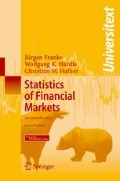Abstract
When we model returns using a GARCH process with normally distributed innovations, we have already taken into account the second stylised fact (see Chapter 13). The distribution of the random returns automatically has a leptokurtosis and larger losses occurring more frequently than under the assumption that the returns are normally distributed. If one is interested in the 95%-VaR of liquid assets, this approach produces the most useful results. For the extreme risk quantiles such as the 99%-VaR and for riskier types of investments the risk is often underestimated when the innovations are assumed to be normally distributed, since a higher probability of particularly extreme losses than a GARCH process ɛ t with normally distributed Z t can produce.
Access this chapter
Tax calculation will be finalised at checkout
Purchases are for personal use only
Preview
Unable to display preview. Download preview PDF.
18.5 Recommended Literature
Embrechts, P., Klüppelberg, C. and Mikosch, T. (1997). Modelling Extremal Events, Springer Verlag, Berlin.
Fisher, R. and Tippett, L. (1928). Limiting forms of the frequency distribution of the largest or smallest member of a sample, Proc. Cambridge Philos. Soc. 24: 180–190.
Franke, J. and Mwita, P. (2003). Nonparametric estimates for conditional quantiles of time series, Technical report, Department of Mathematics, University of Kaiserslautern.
Grama, I. and Spokoiny, V. (2003). Tail index estimation by local exponential modeling, Technical report, WIAS, Berlin.
McNeil, A. and Frey, R. (2000). Estimation of tail-related risk measures for heteroscedastic financial time series: an extreme value approach, Journal of Empirical Finance 7: 271–300.
Mwita, P. (2003). Semiparametric estimation of conditional quantiles for time series with applications in finance, PhD thesis, University of Kaiserslautern.
Pickands, J. (1975). Statistical inference using extreme order statistics, Ann Statist. 3: 119–131.
Polzehl, J. and Spokoiny, V. (2003). Local likelihood modeling by adaptive weights smoothing, Technical report, Department of Mathematics, University of Bremen.
Reiss, R. and Thomas, M. (1997). Statistical Analysis of Extreme Values, Birkhäuser, Basel.
Reiss, R. and Thomas, M. (2000). Extreme value analysis, XploRe Learning Guide, Heidelberg, Springer, pp. 353–374.
Rights and permissions
Copyright information
© 2008 Springer-Verlag Berlin Heidelberg
About this chapter
Cite this chapter
(2008). Statistics of Extreme Risks. In: Statistics of Financial Markets. Universitext. Springer, Berlin, Heidelberg. https://doi.org/10.1007/978-3-540-76272-0_18
Download citation
DOI: https://doi.org/10.1007/978-3-540-76272-0_18
Publisher Name: Springer, Berlin, Heidelberg
Print ISBN: 978-3-540-76269-0
Online ISBN: 978-3-540-76272-0
eBook Packages: Mathematics and StatisticsMathematics and Statistics (R0)

